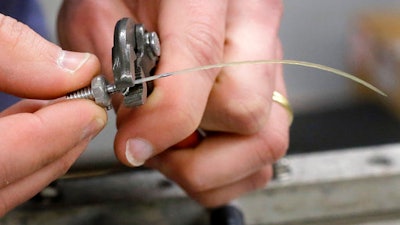
NEWPORT, R.I. (AP) — The U.S. Navy is enlisting the help of seals — but not the kind of highly trained special operatives with whom it usually associates.
Real seals, specifically their whiskers, may be the key to a new way for ships and underwater vehicles to sense their environment, scientists think (view photos in gallery).
When a fish swims by, a hungry seal senses the wake with its whiskers. It can tell characteristics of the fish, such as shape and size, and track the location even when it's murky or dark.
Despite the adorable possibilities, scientists aren't looking to outfit ships and vehicles with whiskers. They're studying how the whiskers function to learn how to reverse-engineer the system. The science could be applied to the development of a future sensor.
"If we want to design the best systems, it makes sense to take advantage of millions of years of work that nature has done for us," said Christin Murphy, a marine mammal biologist.
The research is taking place at the Newport division of the Naval Undersea Warfare Center.
Murphy and colleague Joy Lapseritis looked to seal whiskers because they're a highly sensitive system of underwater touch that employ bumps to reduce their own self-induced vibrations, something that may help increase their sensitivity to water disturbances.
That, Lapseritis said, could lead to a novel, passive sensor.
"You don't need to put sound into the water, like sonar," she said. "This is literally feeling the landscape."
Murphy discussed their work with Ash Carter, then the secretary of defense, when he visited Newport in May.
The warfare center receives funding from the Office of Naval Research for in-house laboratory independent research, including the whisker project. The budget is about $2.4 million annually, with each project typically receiving $100,000 to $150,000 a year, according to the center.
The Navy, which is also funding bio-inspired work at universities, has taken a greater interest in the field in the past decade. Animals do things well that the Navy wants its underwater vehicles to do well, like the way they propel themselves through water and can stay put in the face of currents.
Scientists and engineers at the warfare center are studying a variety of creatures to borrow their best features for potential military applications, from the maneuverability of a bat in flight to cicadas' ability to transmit sound. One researcher is even trying to figure out how a sensor could float like a jellyfish.
The seal whiskers project shows "remarkable promise" for the Navy because a seal's sensory capabilities are so specific and sensitive, said Woods Hole Oceanographic Institution researcher Andrea Bogomolni, who leads the Northwest Atlantic Seal Research Consortium.
This month in the lab in Newport, Lapseritis and Murphy measured the motion of a harbor seal whisker in a tunnel of water as the speed of the flow changed. A cylinder in the tunnel disturbed the water flow like a swimming fish would.
They work with groups that respond to reports of distressed or deceased seals to collect whiskers from seals that die. They have run hundreds of trials with different whiskers and species, and have created a whisker with a 3-D printer. They haven't set a timeline for finishing the project.






















